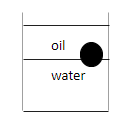
A ball is made of a material of density


Answer
502.5k+ views
Hint: A body will sink in a fluid if the density of the body is greater than that of the fluid and it will float on the surface of the fluid if the body’s density is less than the density of the fluid.
Complete step by step answer:
Step 1: Explain the equilibrium position of the ball in the oil-water mixture using the Archimedes’ principle.
A ball of density
Archimedes’ principle states that the buoyant force acting upward on a body which is fully or partially immersed in a fluid (liquid or gas) will be equal to the weight of the fluid displaced by the body.
This suggests that when a denser object is immersed in a fluid, the weight of the fluid displaced by the object will be more than the upward buoyant force acting on it and thus the object sinks in the fluid. When a less dense object is immersed in a fluid, the weight displaced by the object will be less than the upward buoyant force and thus the less dense object floats on the surface of the fluid.
Here, according to the Archimedes’ principle, the ball will float on the surface of the water and it will sink in oil since,
Therefore, the correct representation of the equilibrium position of the ball in the oil-water mixture will be option (C).

Note:
The density of an object is its mass per unit volume. If an object is heavy for its size it will have a high density (eg: pebble) and if an object is lighter for its size it will have less density (eg: popcorn). The density of an object determines if it sinks or not.
Complete step by step answer:
Step 1: Explain the equilibrium position of the ball in the oil-water mixture using the Archimedes’ principle.
A ball of density
Archimedes’ principle states that the buoyant force acting upward on a body which is fully or partially immersed in a fluid (liquid or gas) will be equal to the weight of the fluid displaced by the body.
This suggests that when a denser object is immersed in a fluid, the weight of the fluid displaced by the object will be more than the upward buoyant force acting on it and thus the object sinks in the fluid. When a less dense object is immersed in a fluid, the weight displaced by the object will be less than the upward buoyant force and thus the less dense object floats on the surface of the fluid.
Here, according to the Archimedes’ principle, the ball will float on the surface of the water and it will sink in oil since,
Therefore, the correct representation of the equilibrium position of the ball in the oil-water mixture will be option (C).

Note:
The density of an object is its mass per unit volume. If an object is heavy for its size it will have a high density (eg: pebble) and if an object is lighter for its size it will have less density (eg: popcorn). The density of an object determines if it sinks or not.
Latest Vedantu courses for you
Grade 11 Science PCM | CBSE | SCHOOL | English
CBSE (2025-26)
School Full course for CBSE students
₹41,848 per year
Recently Updated Pages
Master Class 11 Economics: Engaging Questions & Answers for Success

Master Class 11 Business Studies: Engaging Questions & Answers for Success

Master Class 11 Accountancy: Engaging Questions & Answers for Success

Master Class 11 English: Engaging Questions & Answers for Success

Master Class 11 Computer Science: Engaging Questions & Answers for Success

Master Class 11 Maths: Engaging Questions & Answers for Success

Trending doubts
Which one is a true fish A Jellyfish B Starfish C Dogfish class 11 biology CBSE

State and prove Bernoullis theorem class 11 physics CBSE

1 ton equals to A 100 kg B 1000 kg C 10 kg D 10000 class 11 physics CBSE

In which part of the body the blood is purified oxygenation class 11 biology CBSE

One Metric ton is equal to kg A 10000 B 1000 C 100 class 11 physics CBSE

Difference Between Prokaryotic Cells and Eukaryotic Cells




